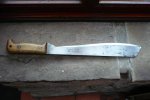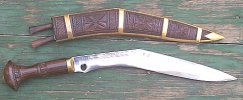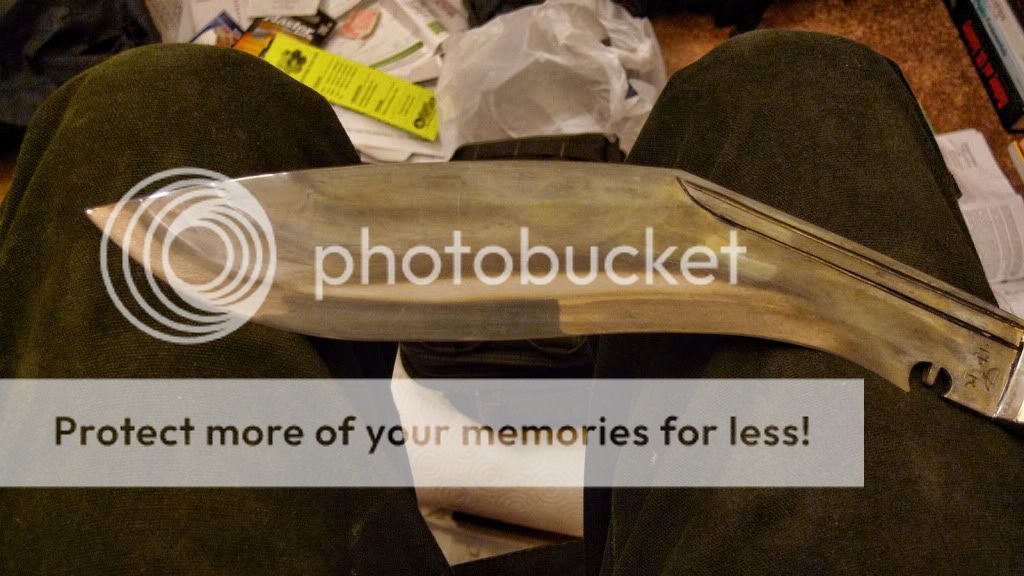5 - steel and metallurgy
This is one of the biggest yet often not understood differences between the companies. HI has always sourced out 5160 or comparable metals, though it may be something slightly different as there are different steels used in car springs like Nissan and Honda's. Their heat treating varies drastically by maker. Generally the sweet spot is always hardened with the spine left soft. Depending on the maker, you may get hardening at the tip and recurve, it may be less hard or it may be very close to the same hardness across the entire edge. The most important part of this is that you NEED to acid etch your blade to see what is going on with the heat treat. If you don't you are gambling and will have to guess at it as you use it based on rolling/mashing/denting tendancies at different positions on the edge. Here is a series of etches I've done:
One of the most beautiful hamon's I've seen on any model, good hardening at the tip, good depth, good on everything. Only a small portion of the ricasso edge is unhardned, but I'm okay with that because it reduces the likelyhood of a stress risor in the often rough edged cho -
all three of these have hardening from the sweet spot to the tip, but all of them are softer at the tip then at the sweet spot. If they are hardened in the recurve, it is less hard than the tip. This is because the water is poured on the sweet spot, the moved to the tip, then moved back across to the recurve, meaning it has air cooled the most before being quenched.
While working around some rocks doing a test between the 18" ang khola and the TTKZ, I bashed the tip of the AK on some of the rocks. This was the resulting damage, and the reason for the slightly softer tip area:
When you view this damage I want you to use a critical eye for the size of the damage and the type. It's very small, not going past my very small 24 degree per side secondary bevel, and it is a roll - not a chip. I have done the same type of miss-swing strike on round rocks with busse's and the damage was almost identical. This is the ideal situation for a khukuri. If the edge was brought up to a full 58-60rc it would have been much more likely to chip. I've done this on too-hard siru's.
This is a very different type of heat treatment from busse. If you say that busse's is significantly better, that does not necessarily detract from the quality and function of HI's methodology. When done correctly (again, etch your blades and find a Kami that is consistent like Bura, Amtrak or Sher) the sweet spot is hard and holds a great edge, the tip is damage resistant and still holds a decent edge, and the recurve is hardened enough for pull/push cutting but soft enough to resist stress risors at the cho. It is a good working system for making knives int he fashion and situation that they are made in, in the hills with a coal fire and a kettle of water. Remember - this is not so different than the water quenches used by master smiths in america who sell their blades for 1,000$+. The quality of the end product is dependant on the skill of the maker.
Which is the point that we come to manufacturing consistency. Busse has this hands down, without question. You can't really hold up an argument that the old methods produce a consistently better blade than modern manufacturing technique because they simply lack the scientific metrology and quality control methodology. Himalayan imports relies entirely on the ability of the maker to see temperature based on color - He will not have control of the temperatures down to 5 degree's like busse will, nor will he have the ability to perceive time down to the second like a modern heat treating oven. They rely entirely on the Kami to see cracks and defects, Busse uses penatrant dye testing with modern equipment like microscopes. The kami relies on assumption based on experience for how hard the blade is, or on the feeling of a fresh file running across the edge - Busse uses rockwell testers that are accurate down to an RC point (or moreso). You can't reasonably argue that HI produces more consistent blades or is less likely to have failures. It isn't possible based on the equipement, technology and education involved.
That said, I go back to my original argument that unless you are in life or death situations you likely won't need the level of consistency Busse affords. Things like this:
are technically stress risors that can lead to failure, but the vast majority of the time they do not develope into larger cracks. And with a slight modification like what you see in my modified handle (I rounded out and polished the cho), the stress risor is almost entirely nullified.
As far as steel and differentially/full hardening - If you can produce a blade that has a higher bend strength (more pressure required to get it to bend, and more pressure required before it breaks or takes a set), and maintain chip resistence across the entire edge while having a a fully hardened blade - There is no benefit to differential hardening. However, if you want a super hard sweet spot that has amazing wear resistance, you can get that out of HI where you can't with busse. All of busse's standard INFI is the same, there is no variability in wear resistance. 5160 put to 62rc will have higher wear resistance than 58rc INFI, but it will be more prone to chipping. It's all in what you want, what you need and what you can afford.
6 - cost
So... the conclusion. Is the TTKZ worth the extra 400-700$? Yes and no. Yes if your life depends on the knife, without question. No if you want something custom fitted to your hand, no if you want a harder edge than busse produces, no if you don't have the money to spend, no if you want different lengths, weights and sizes. Himalayan imports produces quality knives as long as your willing to do a little extra foot work, tracking down the right blade for you, etching it to gaurentee a proper hamon and hardness, and oiling the handles and leather to maintain their quality over time. They are hard working knives that
are time tested - but
never assume that 'time tested'
inherently means better. That is a form of forced ignorance, a blindness to the possibility of better things existing and to the possibility of flaw. This works the other way around,
never assume that because a blade was produced by a CNC machine and a heat treat oven that it's
inherently better than a hand forged knife. Always look at your tools with a critical eye to the first 5 elements described here, always be open to innovation, to change, to betterment. In that same vein of logical analysis - just because a knife is better does not mean it is better
enough to warrant the price paid for it. If a knife of lower cost fits all of your necessary criteria, it is an excellent knife
for you, just because another maker is technically better does not change that.




























































